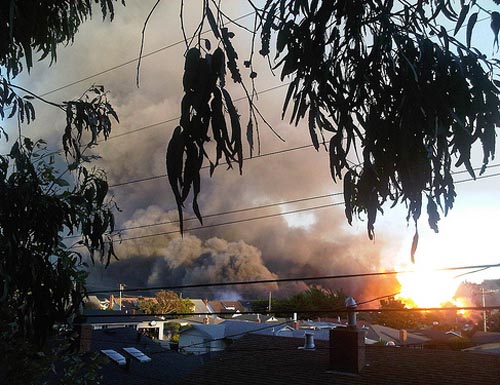 First of all, to view a the public government hearings on the PG&E San Bruno pipeline explosion last September, click here for the live stream.
First of all, to view a the public government hearings on the PG&E San Bruno pipeline explosion last September, click here for the live stream.
The pipeline explosion sent waves of concern throughout the San Francisco Bay Area when it unexpectedly destroyed a San Bruno neighborhood, killing 8 people and injuring more than 50 others. Since, state and federal regulators have launched investigations into the energy provider that have so far revealed faulty record keeping systems that “maybe have been inadequate to make safety decisions.” This week, the National Transportation Safety Board intends to discover whether PG&E broke any laws and should be subject to penalties stronger than a slap on the wrist in a 3-day hearing. Below are some of the major issues that the NTSB will investigate further.
Why Did Gas Continue to Flow Through the Pipeline?
After the pipeline exploded on September 9, it took nearly 90 minutes to shut off the gas valve, as San Bruno fire officers had to drive to the site of the explosion and manually close the valves. This is particularly problematic for PG&E because it has become standard practice to implement an automatic or remote-controlled valves to stop gas leaks off-site, before they cause significant damage.
Today’s hearing in Washington D.C. focused on an internal 2006 PG&E memo downplaying the role of automatic valves. PG&E engineer Chih-Hung Lee said the automatic valves have “little or no effect on increasing human safety or protecting properties.” This statement was contrasted with a 1999 Transportation Department study, which found that automatic valves are essential because a delayed response could mean that “any fire would be of greater intensity and would have greater potential for damaging surrounding infrastructure.”
Why Hadn’t the Pipelines Been Updated for 60 Years?
One of the main problems with PG&E’s shoddy record keeping is that it prevents some old pipeline equipment from being updated when it degrades. The pipeline that exploded in San Bruno was found to be 60 years old, and far overdue for a renovation. Safety experts have acknowledged that the explosion could have been prevented if the pipeline had been repaired recently.
But Robert Bea, a civil engineering professor at the University of California Berkeley said the age wouldn’t be important if the pipeline had been built correctly 60 years ago. “If we’ve got pipelines in important areas where we got people and schools and positals, we better test these pipelines,” he told NPR. “We can’t tell from records what their condition is; only tests can give us the assurance that we’re properly protecting the interest of the public.” Unfortunately, these tests are incredibly expensive, and with the total cost for this explosion exceeding $760 million (so far), it appears unlikely that PG&E will have the capacity to launch the extensive safety tests that are needed.
How Has PG&E Avoided Safety Scrutiny Until Now?
If you live in the Bay Area, you know that minor pipeline explosions aren’t uncommon. Even in the past five years, there have been multiple pipeline explosions that have not resulted in deaths, but have shut off power for much of San Francisco and the Bay Area. But for the most part, these have been considered commonplace and not worth additional scrutiny.
PG&E also has a history of dodging regulations imposed by external safety studies. In 2008, for example, the Pipeline and Hazardous Materials Safety Administration found that pipeline degradation often occurs without visible signs, leaving pipelines more susceptible to future explosions. In 2004, the PHMSA called for “risk-based assessments” on potentially dangerous pipelines near cities. As Wall Street Journal reports, however, “it appears that none of the special measures was taken in the case of the San Bruno pipeline that exploded.”
There’s no doubt that this week’s hearings will lead to additional safety measures taken on the part of PG&E to prevent future pipeline explosions. But it’s clear that individual companies cannot be relied upon to impose sufficient safety guidelines on themselves. To guarantee increased safety, therefore, the NTSB should strengthen its regulations in order to help prevent future tragedies like last September’s San Bruno pipeline explosion.
We’ll keep you updated as the hearing continues. As I mentioned above, watch live here. Also follow The Bay Citizen and San Bruno Patch for more great coverage.
Photo credit: smi23le

